For all that the Schwarzwald is popularly known for its cuckoo clocks, as Mythos SABA - Memories of a Global Company at the Franziskanermuseum, Villingen-Schwenningen, helps elucidate, such aren't the only noise emitting precision technical objects, nor indeed the only harmonies, rhythms, melodies and metres, associated with the (hi)story of, and the cultural contribution of, the Schwarzwald.
If alternative noise emitting precision technical objects and alternative harmonies, rhythms, melodies and metres that are all too often masked by the call of the cuckoo.
And also an elucidation, an enunciation, of the alternatives by the Franziskanermuseum that begins, somewhat inevitably, with clocks.......
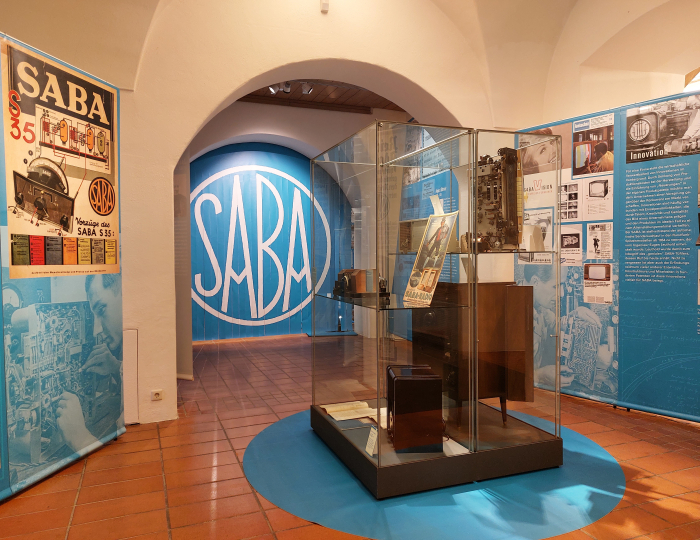
.......but not cuckoo clocks. Rather with so-called Jockele Uhren, a type of small clock that was developed in, and is/was particularly associated with, Schwarzwald; and specifically with those Jockele Uhren produced in Triberg, Schwarzwald, by the eponymous company established in 1835 by one Joseph Benedikt Schwer, a metalworker and filesmith by trade who sought, and found, his luck in the increasingly burgeoning Schwarzwald clock industry of the early 19th century, a burgeoning, international, 19th century clock industry which, in many regards, laid the foundations for the contemporary global associations of Schwarzwald and clocks. Cuckoo, Jockele or otherwise. In 1864 Joseph Benedikt's son, August Schwer, inherited the family business and expanded the product portfolio, including introducing, as one can read in Mythos SABA, the production of pocket watches, for all the cheaper pocket watches of the period that helped democratise an, until then, luxury object, and also, and not uninterestingly, introducing Holzschnitzerei, wood carving, to the company's portfolio; a move to Holzschnitzerei, inarguably, associated with the rise of mass tourism at that period, and specifically associated with that moment in the late 19th century when Schwarzwald suddenly switched form being the daunting, terrifying, inaccessible, blackest of forests it had represented to urbanites for centuries and became a place of wild, authentic, nature to be embraced, marvelled and idealised. And a place of wild, authentic, nature alive with traditions, rituals and, authentic, crafts that were similarly to be embraced, marvelled and idealised. And consumed. Or put another way, the start of Mythos Schwarzwald.
And a move away from Jockele Uhren, and from clocks in general, by August Schwer that was primarily, associated with a wider shift in the course of the late 19th century away from manual clock production and towards a more industrialised clock production in the region, a shift which meant manual production became increasingly unprofitable, undesirable even. And a shift that saw family Schwer explore ever new markets, including, as Mythos SABA helps elucidate, alongside Holzschnitzerei, the production of all manner of metal objects, a neat nod back to grandfather Joseph Benedikt; and metal objects including, for example, razor blades, lest we forget the disposable razor blade was very much an invention of the late 19th/early 20th century and thus a new emerging market, and also bicycle bells, a product which sounds from this distance, pun very much intended, like another most promising growth market in the late 19th/early 20th century. And one not unrelated to clocks, or more accurately clockworks, if at a much lower technical level. But not at a lower industrial level: according to Mythos SABA in 1918 the Schwer's company, or more accurately the company's 78 employees, were producing some 14,000 bicycle bells. A day. You do the math.
And a period that also saw family Schwer begin with the production of bicycle dynamos, another growth product at that period, and one which marks a first experimentation by the Schwer's with electricity, again something still, certainly at a popular, consumer level, in its infancy at that period; an association with electricity that increased when August's son Hermann, who having inherited the family business in 1905, and having relocated the business in 1918 from Triberg to nearby Villingen, established in 1922 an electrical signal engineering department and in 1923 began with the production of radio components and headphones.
Which is where and when the Mythos of the Franziskanermuseum's exhibition title begins.
And where those aforementioned alternative noise emitting precision technical objects — radios — enter the narrative.
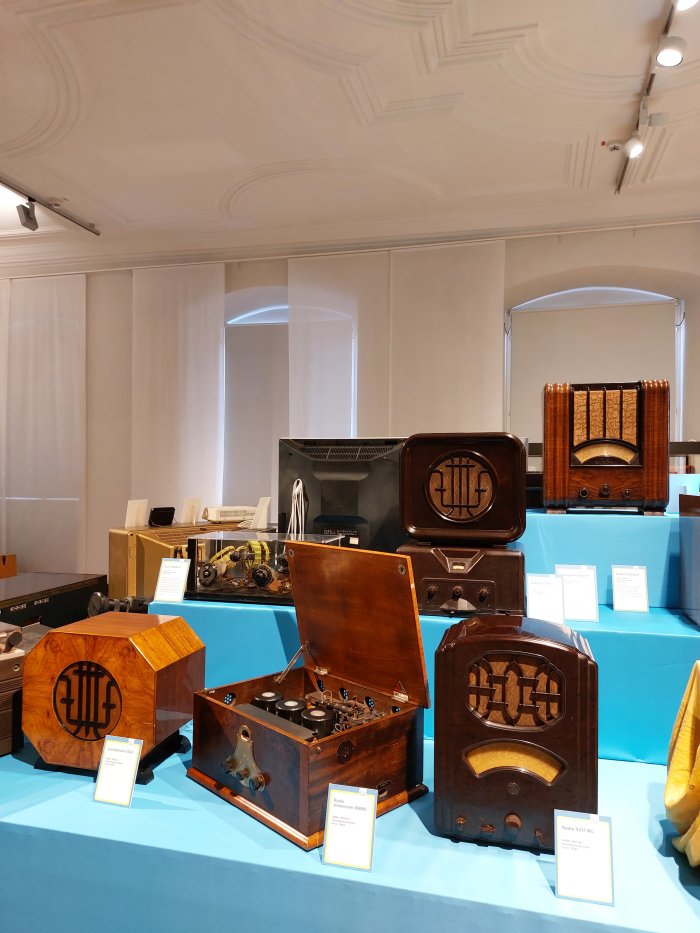
Taking you on a more or less chronological journey through the (hi)story of, through the mythos of, Schwarzwälder Apparate-Bau-Anstalt, Mythos SABA moves on from introducing the company's early, pre-radio, pre-mythos, decades to a chapter focussing on the company's earliest radio decades, a chapter which is very brown: not just brown in terms of the design of the chapter which, and somewhat disconcertingly, diverges from the blue identity used everywhere else in Mythos SABA, but for all brown in its content.
Or put another way, having started with the production of headphones and radio components in 1923, SABA began in 1927 with the production of fully assembled radios including models such as, for example, the HANN 27, achieving a first commercial and critical success in 1931 with the S35, and rapidly building on that success with further models in the early 1930s; a success which meant, as Mythos SABA notes, in 1934/35 the company's, then, 841 employees were producing some 176,000 radios a day year, making SABA at that period, and by all accounts, the largest producer of radios in the, then, Deutsche Reich. Whereby rather than leave you to do the math, this time we'll leave you to do the history.
...
Finished?
...
We'll continue.
While Mythos SABA doesn't link SABA's rapid rise in the early 1930s with the rise of the NSDAP, or perhaps more accurately doesn't attempt to question and analyse or even search for, that, potential, link, it does make extensive note of the unequivocal, admiring, support for the NSDAP and their policies of the families Schwer, Brunner and Scherb, who, at that stage, owned the company, including retelling how first Hermann Schwer's wife, Johanna, and subsequently his daughter, Margarete, took Margerete's sons, Hermann and Hans-Georg, to meet Hitler, the first meeting in Obersalzberg, the second in Stuttgart. Meetings, one presumes, facilitated by close, convivial, contacts. Contacts which, one could justifiably assume, were as important professionally as personally.
And Mythos SABA also helps illustrate, for all via two 1930s SABA adverts, both how SABA employed their unequivocal, admiring, support for the NSDAP as a marketing tool, and how the rise of the NSDAP assisted the rise of radio in the contemporary Germany, and thereby assisted the rise of SABA.
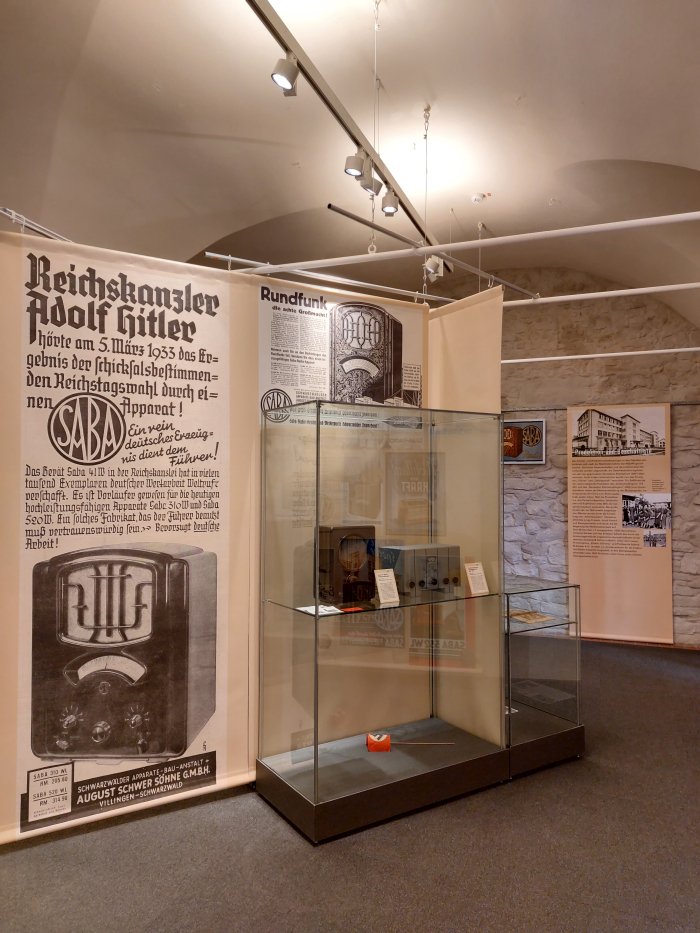
The one advert quoting at length from a speech given by Joseph Goebbels at the 1933 Funkausstellung in Berlin, a speech in the course of which Goebbels compares radio very favourably with the printing presses and bookbinding of previous centuries, celebrates the revolutionary nature of the medium, and notes that "both the conquest and the exploitation of [political] power would have been unthinkable in its current form without radio and airplanes". Which is well worth reflecting on in our age of Social Media and AI and delivery drones. And words tending to be underscored in Mythos SABA by the presence of the Volksempfänger VE 301W and the DAF 1011, the latter a work that no matter how often you see it always reminds you more of a toaster than a radio. A Volksempfänger VE 301W and DAF 1011 that SABA, along with a great many other manufacturers, produced under the umbrella of a collective distributor for sale at a unified price, they were after all radios for a collective unity; and works that remind, as we noted from, for example, From Luther to Twitter. Media and the Public Sphere at the Deutsches Historisches Museum, Berlin, or from Design of the Third Reich at Design Museum Den Bosch, ‘s-Hertogenbosch, and as Goebbels tends to confirm, the NSDAP knew very well how to optimally employ the new media of radio for advancing their nefarious aims, that for all the Nürnberg Rallies are popularly held up as the example of the NSDAP's mastery of propaganda, the much more important work was that unobtrusively undertaken on a daily basis by objects such as the Volksempfänger VE 301W and the DAF 1011 which brought the NSDAP's poisonous propaganda directly to the public in the familiar comfort of their homes and places of work. To paraphrase a Friedrich von Borries, Design Manipulates, Design Forms, Design Disciplines, etc... And if you don't believe us you can always ask your AI smart speaker what they think of the possibilities opened by employing readily affordable, contemporarily designed, novel technology to disseminate your lies and fake news to a captive audience denied alternative sources of information. Or ask Instagram and TikTok about relationships between novel technology and perceived trustworthiness.
The second advert noting, with a great deal of pride and satisfaction, how Hitler "heard the results of the fateful Reichstag election of March 5th 1933 on a SABA device", more accurately heard the results of the fateful and corrupt and undemocratic and stolen Reichstagswahl of March 5th 1933 which, effectively, launched the NSDAP dictatorship, on a SABA device; specifically a SABA 41W, an object which, according to SABA, "has gained a worldwide reputation through the many thousands of examples of German craftsmanship". Which sounds ominous. If an advert that does also imply that the SABA 41W was a somewhat outdated model, noting it was "the forerunner ... of today's high-performance SABA 310W and SABA 520W", thus dissing Hitler for his use of an older, inefficient, model, when more contemporary, high-performance, models were available, which we're sure wasn't their aim. Not least as part of their aim was very clearly to associate SABA with not just the NSDAP, but with the principles and politics of the NSDAP, the advert noting that, "Ein rein deutsches Erzügnis dient dem Führer", "a purely German product serves the Führer" and opining that "a brand used by the Führer must be trustworthy". Like Twitter, or Facebook, or Instagram, or TikTok. Or Truth Social. If that claim had been cleared in advance with Hitler's people, we no know, but given that excellent channels of communication clearly existed, getting that approval wouldn't have been difficult. And it would inarguably have helped sales and the consolidation of SABA's leading position in the German radio industry. Which is important to reflect upon.
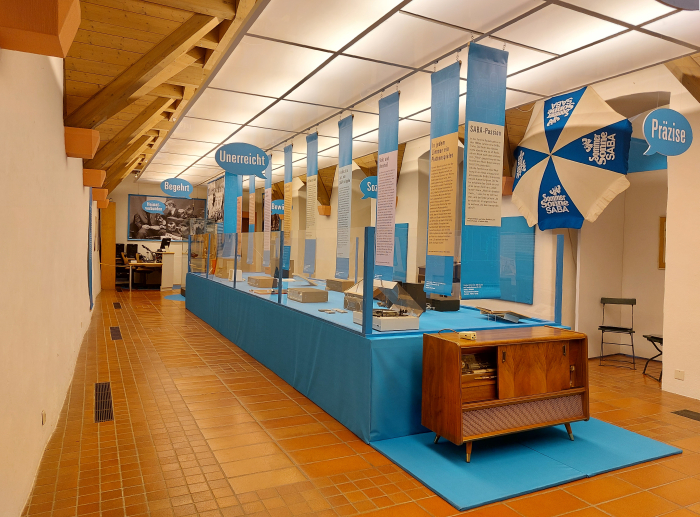
Post-War SABA found itself, as with all in the new West Germany, not only in a very different world, with a new familiar-unfamiliar eastern neighbour, but in a very different market: radio was increasingly being challenged in the home by television, consumer culture was becoming more sophisticated and with it more competitive, the influence of America on popular culture in Europe was increasing and becoming increasingly dominant, while evolving social and culture realities meant that consumers' demands and expectations of their objects of daily use were very different from those of the 1930s.
A new West German context that forced SABA to undertake a number of changes, not only moving away from their Fascism of the 1930s, whereby, and unless we missed it, which is always possible, Mythos SABA doesn't make any reference to a formal, public, post-War examination of their unequivocal, admiring, support for the NSDAP and their ideals, nor make mention of any apology for their willing role in supporting the NSDAP dictatorship, but then, as we all know, in the immediate post-War decades West Germany was far too busy proving it wasn't Fascist to admit it had been and to actively question why it had been. Regrettably. While in terms of products SABA not only began producing a range of novel audio-visual product lines, including televisions, projectors or tape recorders, but also moved into the production of fridges: radios in winter, fridges in summer as the motto went. Yet for all that fridges in the 1950s could, can, be considered a move into a new emerging market much as Holzschnitzerei, razor blades, bicycle bells and radios had once represented, fridges weren't as successful as the company's previous embracings of new markets, and as Mythos SABA explains, the relative disaster that was SABA fridges caused a serious crises in Villingen, a crisis that in 1961 became the responsibility of the aforementioned brothers Hermann and Hans-Georg Brunner-Schwer when they inherited control of SABA.
And a crises from which, in many regards, SABA never recovered, and which greatly contributed to the Brunner-Schwer's selling SABA in 1967 to the American telecommunications conglomerate GTE, who in turn sold it in 1980 to the French electronics concern Thomson-Brandt; and while production continued under the name SABA in Villingen, after 1972 in Villingen-Schwenningen, and that, periodically, successfully, as Mythos SABA notes in 1973 the company employed some 6,000 staff making it one of the largest employers in the, still young, Villingen-Schwenningen, it was production for an increasingly global market in which SABA struggled to maintain its position, for all through the ever fiercer competition from the rapidly growing post-War Japanese electronics industry, but also on account of the rise and rise and rise in the immediate post-War years of an increasing number of domestic West German competitors, including, for example, and amongst others, Grundig, Graetz, Braun or Standard Elektrik Lorenz, SEL, who all denied SABA the leading position and dominance it had enjoyed pre- and intra-War. Struggles which saw the workforce in, and relevance of, Villingen increasingly decline; and struggles which ended in 2008 when, some 85 years after the firm's establishment, the last surviving SABA subsidiary was declared insolvent.
We'll leave you all to compose your own puns about time running out and/or about time being up for SABA.
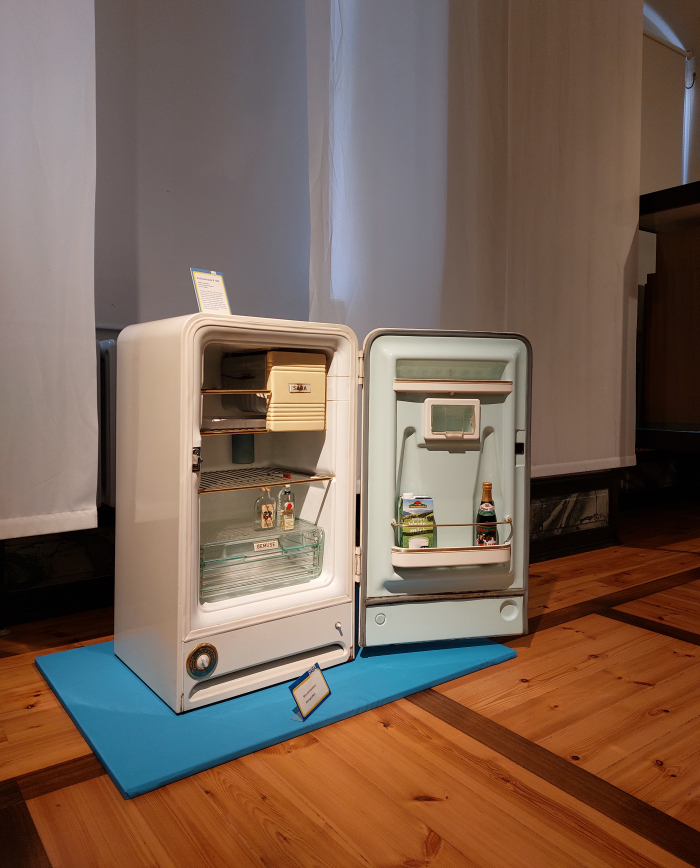
For all that Mythos SABA places the objects developed, produced and sold by SABA over its eight and bit decades at the forefront of its presentation, as an exhibition it is less about those objects per se as an exhibition guided and led by those objects; an exhibition which employs the objects presented to introduce and discuss the various chapters in, and facets of, the company's (hi)story and in doing so not only helps allow access to differentiated insights and perspectives on that (hi)story, on SABA and on the Mythos of the title, but also allows one to employ the (hi)story of SABA for a myriad wider considerations.
Objects such as, for example, the so-called Konigin von SABA from 1961/62, an outrageously decadent and over-dimensional television-radio combo that even from this chronological distance looks out of time, looks as if it genuinely did arise in the ancient Kingdom of Saba: whereas in earlier decades domestic radios were regularly designed to resemble furniture objects, not least for reasons of propriety and decency, by the 1960s positions were changing, relationships were changing, as society changed, and radios, TVs, etc, were increasingly being designed to resemble radios, TVs, etc, and were becoming much smaller and less imposing than the immoderately monstrous Konigin von SABA. Similarly the Feldberg 16 from 1965/66 which the curators note "represents the modern Nordic design of the period", a nice reminder that the much celebrated, and far too lazily referenced, Scandinavian Design is not an actual thing but a long established marketing conceit; and while the Feldberg 16 may or may not represent "the modern Nordic design of the period", not only does it place a radio inside a sideboard to it hide behind a t**** facade and so save the owner from admitting their possession of it, but it certainly doesn't represent the modern slimmed down, space-saving design of the period: it's a massive piece of radio furniture for the mid-1960s, an object that would take up an awful lot of room you don't have in a 1960s apartment. 1960s apartments it is questionable an object of the scale of a Konigin von SABA could even have entered. And thus while the contemporaneous Sabette, Sabinette or Transatlantic demonstrate that SABA could do small and reduced in the 1960s, the Konigin von SABA and the Feldberg 16, amongst other exhibits, allow one to question the strategy SABA followed in the immediate post-War years, to question the basis of the product and portfolio decisions being made at SABA, and thereby to approach an appreciation that the problems of the 1960s went further than just the echo of their fateful fifties foray into fridges. And works that thereby also allow for reflections on a comparison of SABA with Braun.
Objects such as, for example, the so-called Jim Nature television by Philippe Starck, a work featuring a not uninteresting nor uninformative case made from recyclable pressboard, and also the Oyé-Oyé portable radio by Eric Jourdan & Philippe Starck, both from 1994, and both of which flopped spectacularly: and that, potentially, primarily, as the curators note because both were/are relatively backward-looking products in terms of technology and functionality, rather than being the attempt to define a future for audio-visual equipment as we approach the 21st century with its promise of the limitless possibilities of the, then, fledgling World Wide Web, that is surely, surely, the reason one would engage a Philippe Starck in the early 1990s, a period when Starck was still relatively dangerous. If not as dangerous as a decade previous. But future-orienated objects SABA clearly weren't that interested in possessing. And thus objects which allow access not only to considerations on both that folly so many contemporary company's undertake of thinking that just because you hire a big name designer all your problems will be solved, and also allow access to considerations on that way designers accept commissions they really shouldn't, and do so, one presumes, because the cheque being offered is simply too large to ignore — which, yes, is a criticism, a potentially unfair criticism, but one we're making nonetheless — but also allow one, once again, to question the strategy SABA followed. And also allow one to question the role design played in the company, or more accurately, we'd argue, the role design didn't play. Whereby we're referring to design less in terms of the formal expression per se as in terms the relationships between objects, users, society, contemporary realities, and the formal expression thereof. Viewing Mythos SABA one is, certainly we were, struck by a general lack of interest in design expressed by their objects; SABA objects largely, we'd argue, communicating with you in generic terms rather than advancing an independent and considered position to contemporary social, cultural, economic, environmental, technical et al realities. Which isn't to say SABA didn't produce interesting, engaging objects, they very much did and there are numerous on show in Mythos SABA, even if one does have to view a myriad less interesting and engaging models to find them; is however to say that SABA were, we'd argue, and we're open to being challenged, responding to what others were doing rather than to the realities in which their products were being produced. Were market led not design led.1 And works that thereby also allow for reflections on a comparison of SABA with Braun.
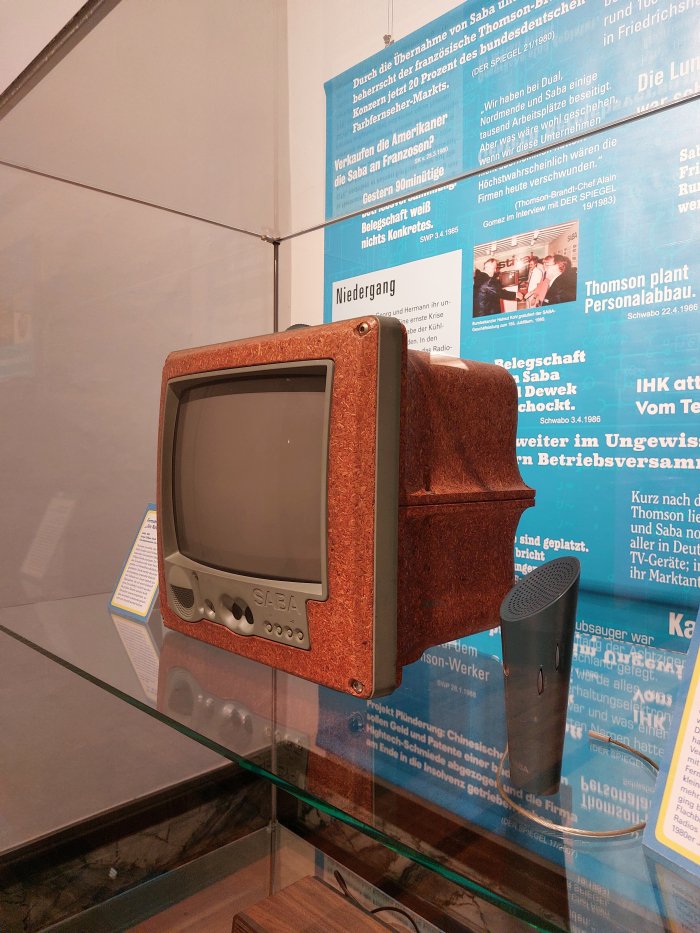
Objects such as processing chips from ca 1977 for the so-called RS970 digital radio, an attempt, as can be read in Mythos SABA, on the part of the company to produce the first Hi-Fi with an integrated micro-computer, a product developed in Villingen, and chips, along with numerous other objects, that remind of the cutting edge technological research and development undertaken at SABA, arguably since the firms earliest days, but certainly since the 1950s, a reminder that for all SABA was a producer of audio-visual equipment it was in many regards more a developer of audio-visual equipment: that last SABA subsidiary to close in 2008 was a research and development platform. And thus late 1970s chips which also reprimand us a little for saying above that SABA were market led not design led, because they were also technology led. If, we'll continue to argue, market led not design led. And a RS970 that, by all accounts flopped, expensively when a Japanese competitor released a cheaper digital hi-fi. And works that thereby also allow for reflections on a comparison of SABA with Braun.
Objects such as, for example, the radio Villingen from 1950/51, the first model from SABA's post-War Heimatseries, a series that also included, for example, the models Freiburg, Triberg, Schauinsland, or the aforementioned Feldberg. And a Heimatseries that although the various models underwent numerous changes and developments over the decades of their productions, very much seek to anchor SABA in the (wider) Schwarzwald region, and for all seek to associate SABA with the popularly accepted traditions and heritage and characteristics of Schwarzwald. To associate SABA radios with Schwarzwald clocks and Schwarzwald Holzschnitzerei. To associate SABA with Mythos Schwarzwald. A strategy that, as can be appreciated in Mythos SABA, was widely employed in the post-War SABA marketing where references to and images of a symbolic, figurative, idealised Schwarzwald are very much at the forefront, very much that on which SABA were hanging their reputation; indeed one could argue, again possibly unfairly, but we're doing it anyway, that the blanket use post-War of Mythos Schwarzwald as a marketing instrument to underscore the value, reliability and desirability of SABA products replaced the previous use of the NSDAP to underscore such. And a rigorous employment of Mythos Schwarzwald that a great many companies employ today: viewing the wall of SABA adverts in Mythos SABA you understand that most all could be contemporary adverts for contemporary Schwarzwald based companies, the manner in which Mythos Schwarzwald is used to sell hasn't changed since the 1950s. The credo remains: if in doubt, Bollenhüte. These days, ideally, paired with tattoos, to prove your a bit edgy, a bit street, obviously. Which is well worth reflecting on. Not least in context of the untold other global regions where a perceived tradition and character and heritage is employed as a marketing crutch. Thoughts which, yes, bring us back to the associations of craft and identity, of craft as identity, discussed in Craft as Myth. Between Ideal and Real Life at the Museum Angewandte Kunst, Frankfurt, and also back to Jørgen Roos’ 1961 film Danish Design and its assertion that "the reputation today enjoyed by Danish design is based on time-honoured tradition and quality craftsmanship", see also the aforementioned Feldberg 16 and its "modern Nordic design". And see also the contemporary Danish furniture industry. And works that thereby also allow for reflections on a comparison of SABA with Braun, a company who, and as discussed from Braun 100 at the Bröhan-Museum Berlin, sought in the 1950s very much to position themselves in context of contemporary American culture, before becoming strongly, as in inextricably, associated with the technological and economic rise, dominance, of post-War West Germany, an association with post-War West Germany that, arguably, can also be considered a component of Braun's success, not least their international success, an international success that, and despite the exhibition's title, SABA didn't really enjoy. And that despite being very much a technological research and development platform.
And reflections on a comparison of SABA with Braun we, yes, are very, very keen to make. And so will rather than simply referring to the possibilities of making them.
Or at least briefly, although we will return to the subject at a later date, for although Braun are but one of a great many West German electronic consumer goods manufacturers one could compare with SABA, the comparisons with Braun are many and, we'd argue, informative: both, for example, have an association with clocks, Braun as a manufacturer, SABA as a descendent of a manufacturer; both were formally established in the early 1920s; both first made a name for themselves with the production of radios in the early 1930s; both produced the Volksempfänger VE 301W and other military hardware during the war years; both were managed post-War by two brothers, the one of whom was more business orientated the other more culturally orientated; both produced not only radios but household electronic goods, Braun concentrating on smaller objects such as, for example food processors or coffee machines, SABA on fridges; both have an association with razors, Braun as a manufacturer, SABA as a descendent of a manufacturer; both were sold in 1967 to an American conglomerate; Braun enjoyed phenomenal success in post-War West Germany and although they stopped producing audio-visual products in 1990 remain a by-word for audio-visual innovation, SABA.......
Not that it was all advantage Braun. SABA had something Braun didn't, and which brings us to not only one of the, for us, more important components of the SABA (hi)story, but to the aforementioned alternative harmonies, rhythms, melodies and metres SABA brought to the cuckoo heavy soundscape of Schwarzwald.
MPS, Musik Produktion Schwarzwald
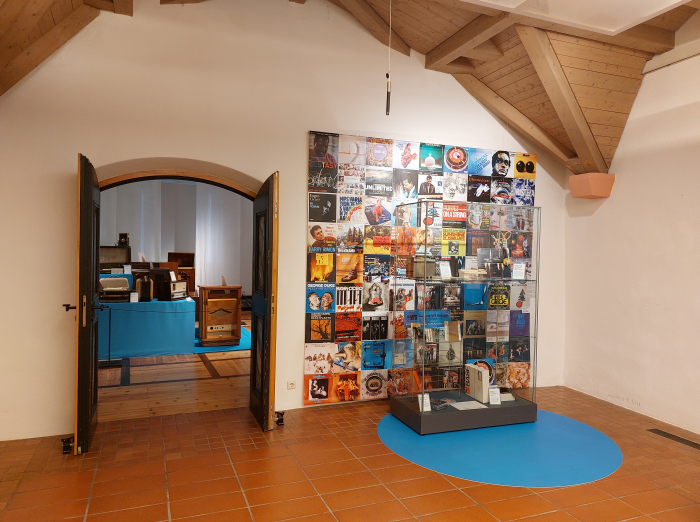
A component of the SABA (hi)story that for all its interest and importance, and for all we have been long been obsessed with it, limitations of time and space mean we must reserve for another day; save to note here that, and as can be followed in Mythos SABA, MPS began in the early 1960s as an, if one so will, instrument, pun again intended, to help assist sales of SABA's new Sabamobil portable cassette player: yes, as with Holzschnitzerei, razor blades, bicycle bells, radios or fridges, another emerging market into which SABA sought to expand, and one they entered with their own cassette format — the compact cassette was still in development in the early 1960s and a standard was still to be established, and SABA's development of their own system being again reflective of their innovation, and their costly failure to establish their innovations as industry standards. And a unique cassette format that required SABA to produce its own catalogue of cassettes so that users had something to listen to; a catalogue that became the responsibility of the SABA record label under the direction of Hans-Georg Brunner-Schwer, or HGBS as he's popularly known. Following the sale of SABA in 1967 SABA records became MPS in 1968 and under the continuing direction, business and artistic, of HGBS increasingly focussed on jazz, HGBS's great passion. And a switch which saw an impressive and varied roster of global jazz musicians travel to Villingen to record with HGBS in the MPS studio within the family villa next to the SABA factory. A, we'll argue, very singular moment in the (hi)story of music in West Germany, one its' very difficult to get your head fully around; and while the, lets say, eclectic nature of the label's output means it not one that we personally can enjoy it its entirety, it is one that is well worth exploring, for there are without question some utter gems to be be located if you're prepared to work your way through the, let's say, less engaging works. Which, yes, does make the MPS archive a lot like the SABA archive.
And jazz records realised by a roster of artists of all religions, skin colours, nationalities, sexual orientations, et al that HGBS's grandparents really, really, wouldn't have approved of. And which in being such not only indicates that HGBS wasn't overly negatively affected by his regular childhood meetings with Hitler, or indeed the familiar atmosphere of his childhood, but for all celebrates why HGBS's grandparents were and are so very, very wrong. As does the mix of nationalities who worked for SABA in the post-War decades, a mix that, as can be appreciated in Mythos SABA, was anything but rein Deutsch, purely German(ic), and thus a reminder that the economic boom of post-War West Germany wasn't a rein Deutsch achievement; neither, as one learns in Mythos SABA, were the workers who helped SABA establish itself as a radio producer in the 1930s rein Schwarzwald, rather a great many of them came from Thüringen, a similarly heavily beforested region of Germany with a long history in precision technical work, and Holzschnitzerei, and which in the 1930s was similarly at the leading edge of new industries. And which further reminds that the 19th century clock industry in Schwarzwald was also heavily reliant on migrants from across Europe for its success, and for establishing its status today as defining for the region: the Deutsche Uhrenstraße, the German Clock Road/Route, starts far outwith the borders of Schwarzwald. And thus by extrapolation underscores the importance of migration in the development of any society and community; elucidates that as with all aspects of nature, monoculture, and for all a forced monoculture based on a perceived, mythological, naturalness and authenticity, is not only counterproductive but highly toxic.
Just ask the Schwarzwald foresters.
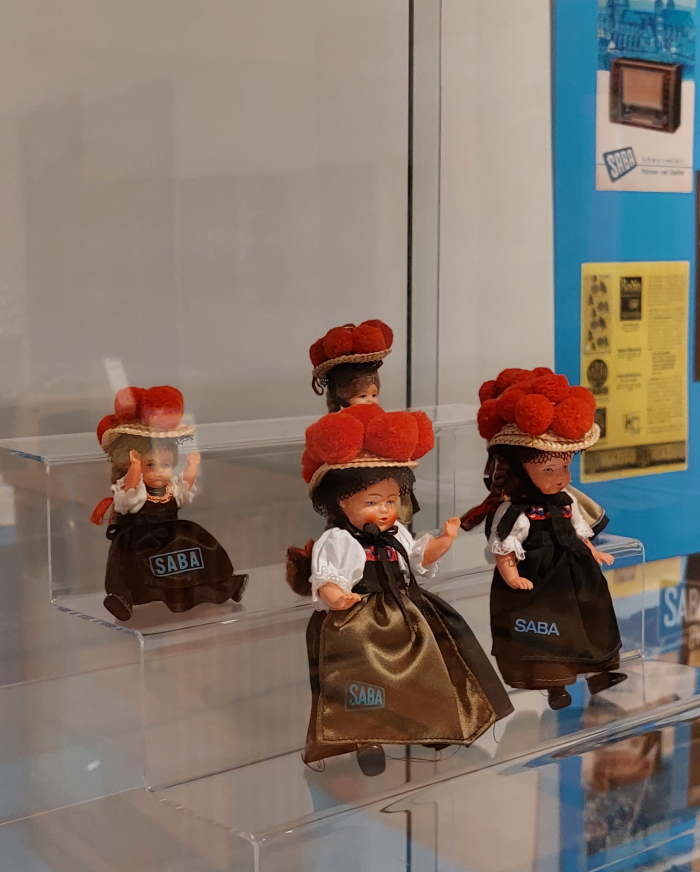
A relatively bijou, if thematically expansive, exhibition, featuring a very pleasing mix of documents, photos, adverts and consumer electronic goods, supported by concise, comprehensible, if sadly only monolingual German, texts, Mythos SABA very pleasing gives a large part of the telling of the (hi)story of, the mythos of, SABA, to the Sabanesen, the SABA employees, thereby enabling a telling of the (hi)story and mythos beyond that of the historian and archivist, while in its mix of objects, perspectives and narrative threads, including diversions into, for example, the culture within SABA and the numerous social and cultural programmes the company initiated and entertained by way of not only trying to foster a familiar atmosphere but also to support the Sabanesen beyond the legal demands of an employer, and that in an age before dishonest Employer Branding complicated undertaking such initiatives, not only allows for differentiated insights and perspectives on and of SABA, but also reminds that SABA is and was part of the (hi)story and culture and economy and structure of the region. Which, we'd argue, is an important factor because SABA is not only slowly vanishing from general memory, slowly slipping into an unearned popular anonymity, but is also slowly vanishing from Villingen: before visiting the Franziskanermuseum we popped up to the Peterzeller Straße to visit the former SABA factory, just to get ourselves a little in the mood, to soak up the atmosphere, get a bit of that SABA spirit.......
.......it's been demolished. Not all of it, but a very important part of it. By the looks of it to make way for housing.
Yes, last time we were there, which was admittedly pre-Covid, it was looking a bit sorry for itself, but knocking it down seems extreme.
On the hand, unless there are serious, insurmountable, structural reasons for demolishing a building the priority today must be to keep it: repurposing, reusing, recycling buildings must become as normal as repurposing, reusing, recycling our other objects of daily use. We must, must, reach a popular appreciation that buildings contain resources that requires the use of further resources to destroy them and then to replace them with new resources whose creation involves the use of even further resources. Which is wasteful. Unnecessarily so when you have an existent building.
And on the other hand SABA is part of why Villingen is what it is today: economically, structurally, physically, socially, culturally. Would the Riettor be demolished to enable a new road? Would the Middle Ages Stadtbachsystem, the open, narrow canals that run through the old town and once brought water to the populace, be filled in to prevent accidents? Would the town wall be demolished to make way for housing? No. No. And thrice no. The building that houses the Franziskanermuseum was established as a monastery in the 13th century, a role it played until the late 18th century, after which it served numerous secular functions before in 1978 being transformed into a museum and cultural centre. And while we know an awful lot of architects who would love to demolish such a building and realise their own vision of a contemporary cultural centre and museum on the site, invariably one that referenced the monastery that once stood there, you can't imagine the authorities would allow that because the monastery is part of the (hi)story of Villingen, part of why Villingen is what it is today. And the SABA factory?
And, no, we're getting all romantic on you, you know us better than that, you know that we concur with Wir Sind Helden on the horrors of Denkmäler, monuments; but we will and do argue for a shift in priorities in urban planning and an understanding of buildings, all buildings, regardless of their age, as possessing a value, a cultural, a social, an energetic, an environmental value, above that of the financial value of ground on which they stand. And certainly far above the vision of an architect.
The MPS villa is thankfully still there, still standing as tranquilly and as peacefully and as unassumingly as we imagine it always has, even when it was a small corner of the hectic global jazz world tucked away in Villingen.
But SABA is vanishing from Villingen. A slow slide from visibility that the Franziskanermuseum, in our reading of their exhibition, fear could, will, lead SABA to become the Mythos of the exhibition title, a Mythos the Franziskanermuseum seek to save SABA from becoming through not only telling an unromanticised, honest, critical (hi)story of the company, through a juxtaposing, a challenging, of memories with facts, and a juxtaposing, a challenging, of successes with failures, problems, errors and pure bad luck, if by necessity of limitations of space in an abbreviated form, it could be a much more expansive presentation, is a start not an end; but for all seeks to save it from the dangers of mythology through employing the (hi)story of SABA to challenge, deconstruct, the Mythos Schwarzwald SABA itself sought to be known and understood by, seeks to save SABA from being remembered in coming generations as Freiburg, Triberg, Schauinsland, Feldberg, Villingen, handcraft, cuckoo clocks, Holzschnitzerei and Bollenhüte. Seeks such by helping you approach a better appreciation of how SABA contributed through their research and development work, and their (at times very successful) contribution to the development European radio industry, to an evolution and progression of the technical, precision work on which the Schwarzwald had once established a reputation, in new, contemporary, contexts, through discussing how SABA helped the Schwarzwald transform and develop with the realities of the age, how SABA helped extend and expand that which Schwarzwald is and was, how SABA helped enabled Schwarzwald to become a same same but different Schwarzwald to that in 1835 when Joseph Benedikt Schwer started producing Jockele Uhren. How SABA helped the Schwarzwald to become more than an idealised authenticism, an idealised myth to be marvelled at. Even if location marketeers, then and now, don't want you to hear that. Just want to you hear the cuckoos.
Mythos SABA is a good, and timeous, place to start listening more attentively to the Schwarzwald, and in doing so to approach not only a more realistic, probable, appreciation of SABA and its place and relevance and legacy in and to both post-War West Germany and the global electronic consumer goods industry, and also of what SABA can teach us all about corporate management, development and identity, but also allows you to approach a wider, more durable, more honest, appreciation of the Schwarzwald, its (hi)story, and its cultural contribution
Mythos SABA - Memories of a Global Company is scheduled to run at the Franziskanermuseum, Rietgasse 2, 78050 Villingen-Schwenningen until Sunday July 16th.
Further information can be found at www.franziskanermuseum.de/saba (German only)
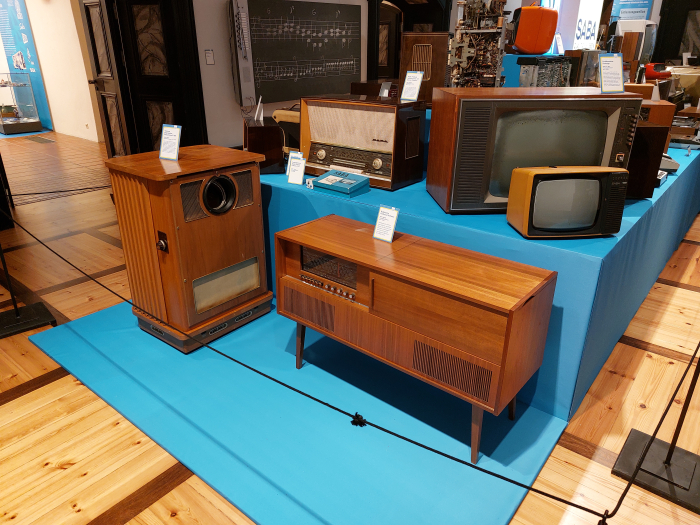
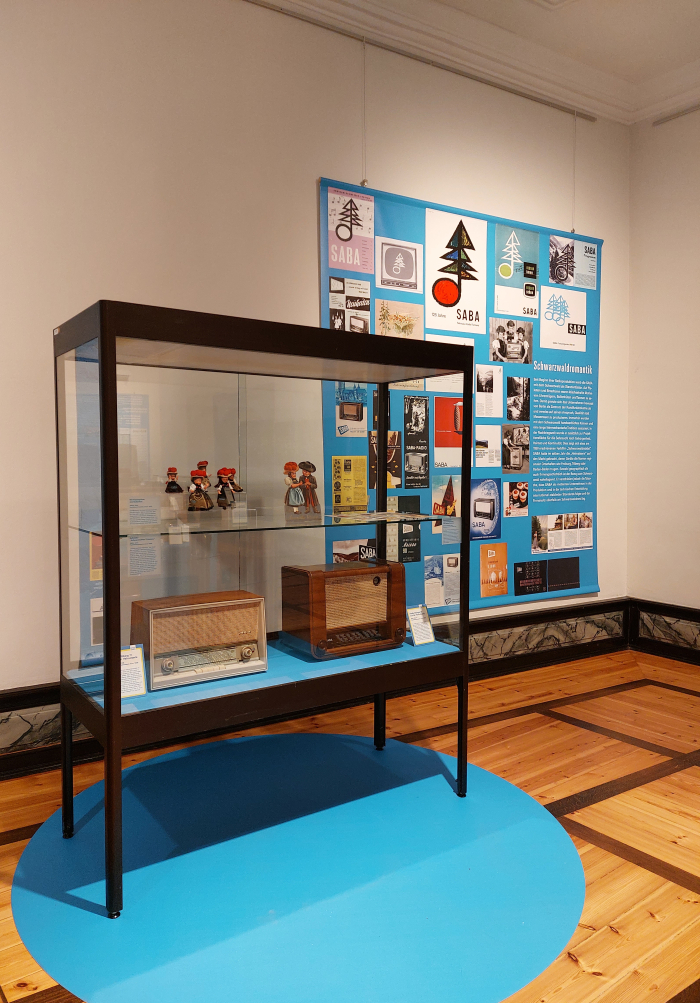
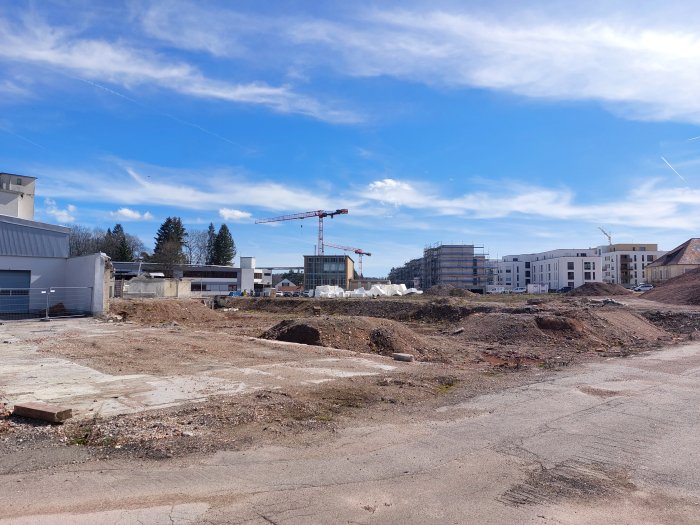
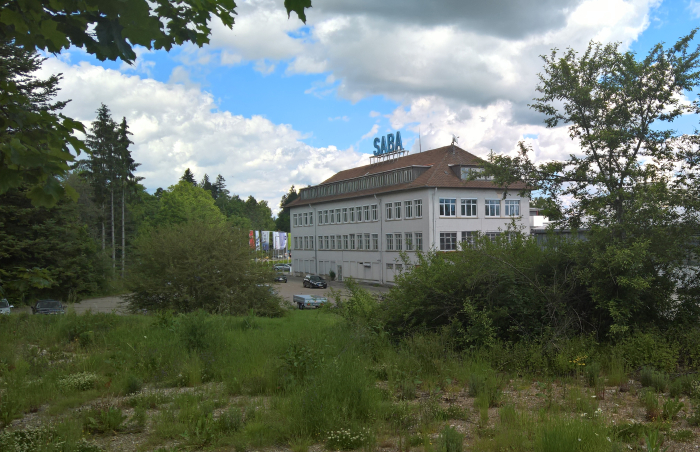
1Yes, in terms of audio-visual equipment, certainly radio equipment, sound reproduction is the more important factor, and we're more than happy to assume that SABA products were very good in that respect, but not only does Mythos SABA not allow one to approach the subject, but in many regards you can't without going back in time and listening to contemporary radios in the period of their creation and in comparison with other contemporary radios.